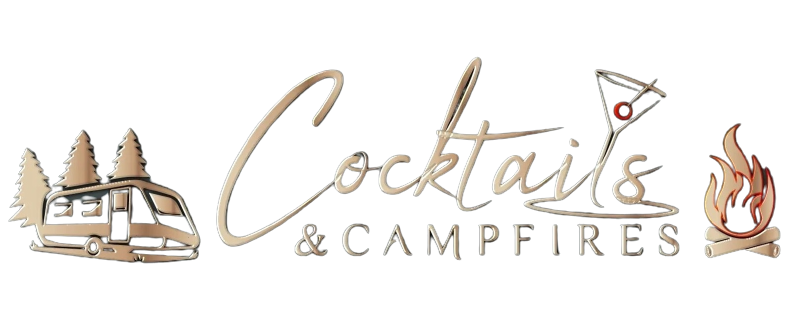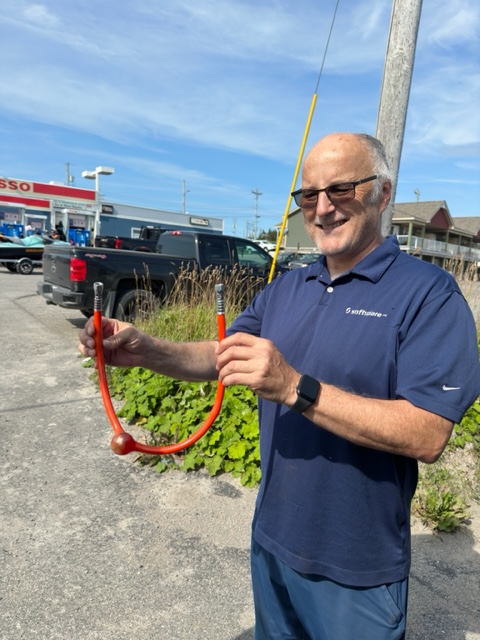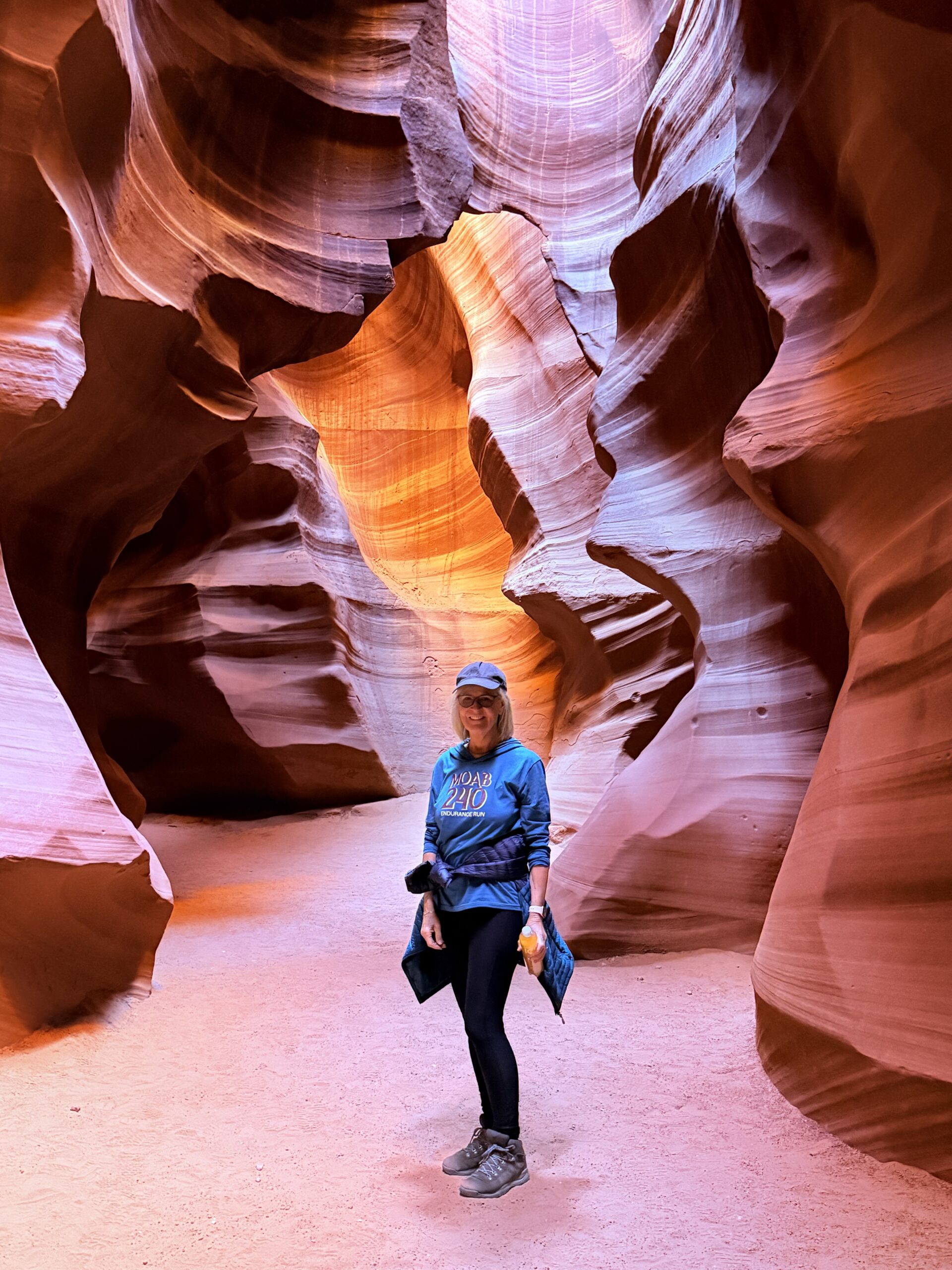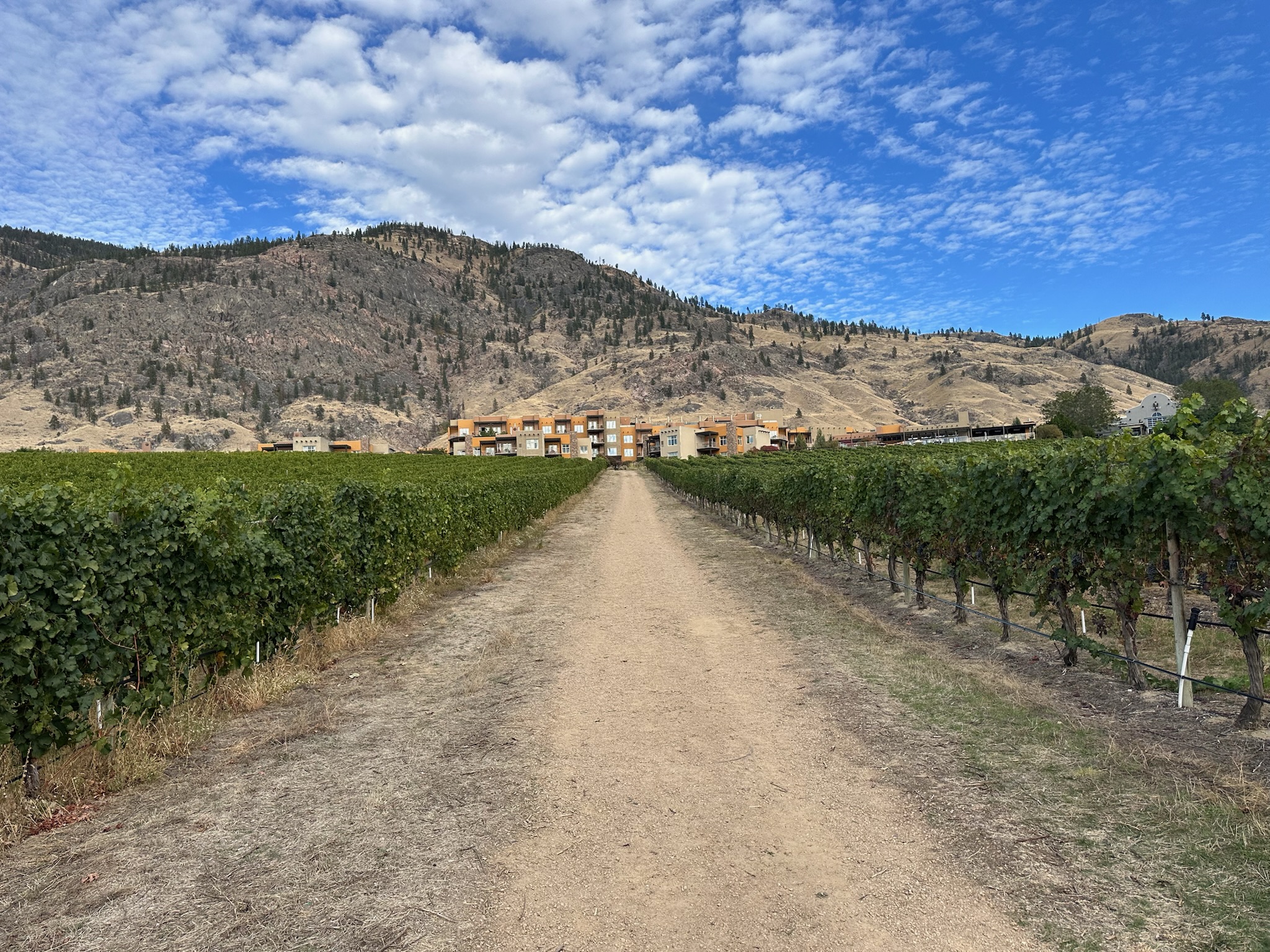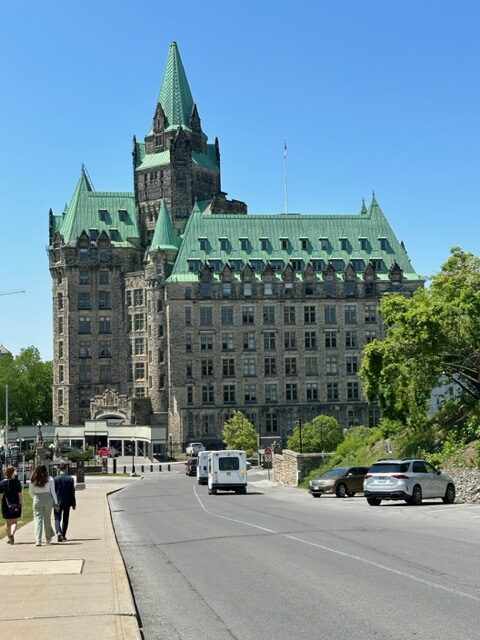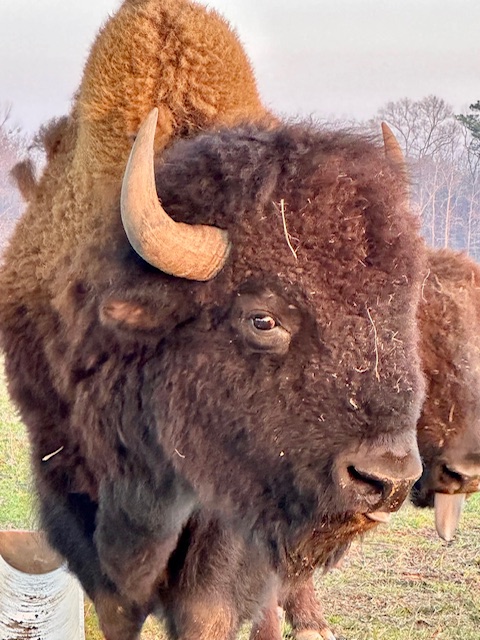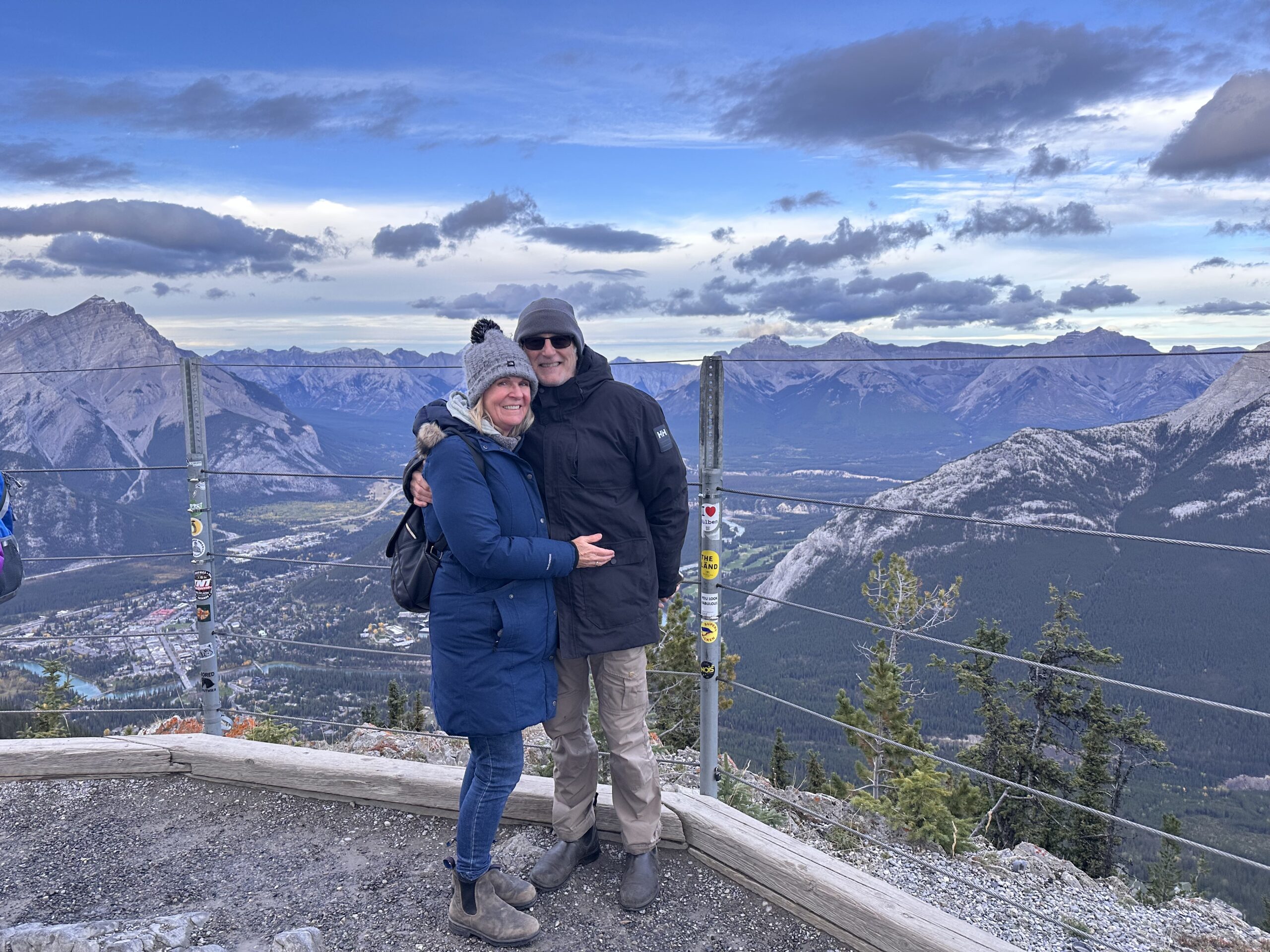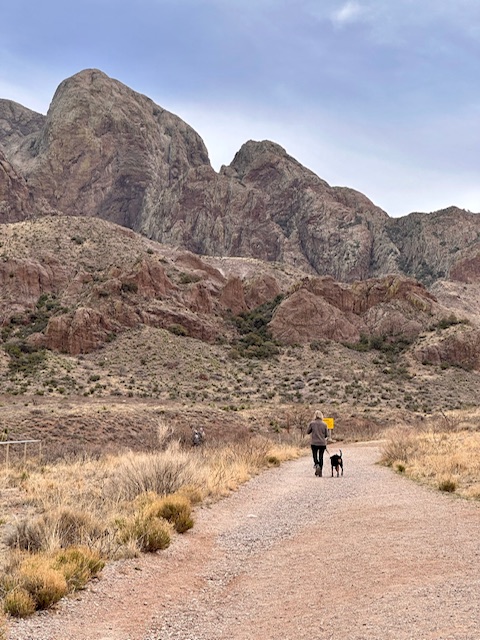St Barbe RV Park was a medium sized, square gravel, fenced in area with an Amenities building on the side. No sewer, but power and water and unlike our last site – but no issues with either, so that was a relief. In the immediate area there was an Inn with restaurant across the road which also had a ticket office for the Labrador Ferry – the road in front of the RV park terminated at the Ferry terminal. Next to the campground was a convenience store with a couple of gas pumps. A few houses in the area but not many.
It was very misty and wet on the drive up to St Barbe and that trend continued the next day. Being a Monday we just hunkered down and got some work done and then took Jax for a short walk down a trail outside of the RV park which went parallel to the road and then wound around the coast with right to the ferry terminal or left to Pigeon cove.
The following day we drove to Flowers Cove to check out their infamous Thrombolites – I just love that word – it just rolls off the tongue like a song. To get to the Thrombolites we crossed a small, covered bridge and then walked along a coastal trail filled with yellow wildflowers. There were quite a lot of these bun shaped, rock like fossils, which were created by marine micro organisms over 500 million years ago. Apparently they are very rare with less than a handful of places on Earth that have them. On the way back to the car the heavens opened and we got drenched. These downpours are generally quite short lived, but when it does come down – it comes down in buckets.
The next day, I was up early as usual and sitting down with my coffee to do my morning Facebook posts when suddenly I got this message that my account was suspended due to community rules. What the hell! I looked at the rules but I couldn’t figure out what I had done wrong, so I immediately appealed. It was such a pain because I couldn’t see anything on my feed either and was concerned that my business facebook account plus all my Instagram personal business accounts were down too. Luckily it was only my personal page. This luckily resolved itself the following day.
The next day was move day so as usual I got up early and began the chore of packing up the entire RV and making food for us to eat on the road. We had about a 2.5 hour drive ahead of us, which wasn’t too bad. I finished everything and then packed all the stuff in the car and handed over to Derek to do his bit with the slides and utilities and hooking up the RV to the hitch etc. Out of sheer luck, Derek decided to take the large box of Jax’s toys from the inside couch and move it to the front compartment under the RV, as toys keep on falling out of the box when we were driving and getting stuck in places. As he opened the front compartment he found one of the hydraulic lines that control the extension of our jacks (6 of them keep us level when not attached to the truck) was bulging (not good) and could rupture at any moment – just when we are sitting in the middle of rural NL! He called Lippert (manufacturer) in Indiana USA, always great people to talk to – less than 10 minutes and they promised to ship us a new hose under warranty. In the meantime we have to stay put – but we couldn’t take the RV anywhere until the new part arrived (very optimistically 5 business days or ??)- oh and to add to the challenge of “remote” camping our tanks (shower and sink) were full – toilet not full yet – because we had planned on dumping them as we left the RV site) but now we couldn’t move. Derek ended up filling up 201 buckets with water from the tanks and carrying them to the dump drain 100m away – fun!
In anticipation of having to change the hydraulic hose Derek went to the local home hardware to get a small wrench 9/16” and the smallest he could get was 1 1/4” Now the race was on between getting the hydraulic hose and being able to move to dump the toilet tank and receiving a portable tank (shipped from Canadian tire Corner Brook) to drain and empty the tank (no way we can use buckets for that!) all before filling the tank … mercifully there were bathrooms and showers here at the RV park – oh the joys! On top of it all we were told there was a water boil advisory so we couldn’t drink the water.
We extended our stay at St Barbe and went about cancelling both our campground and iceberg/whale boat tour in Quirpon. which really sucked. After a day of moping, we decided to still go to Quirpon and find a place to stay overnight, as we were looking forward to seeing the historic Viking site. So Saturday morning, we packed up everything and drove up. We very quickly realized that not taking the RV up this route was actually a blessing in disguise as the roads were in really bad condition and full of potholes.
The area around Quirpon was absolutely stunning. It was a lovely hot day for a change and perfect for taking in the views. We drove straight to the L’anse de Meadows historic site, a designated UNESCO heritage site, and the only authentic Viking site in North America. After a walk up the mountain behind the visitors centre to where they have a metal statue of Vikings and an incredible 360 degree view of the area complete several ice bergs floating off the coast, we went to the Visitors Centre. There we took a tour with one of the Parks Canada staff through the archaeological remains of an 11th century old base camp the Vikings used as they explored Newfoundland and beyond for items of significance. We also saw a reconstruction of a Norse house filled with weaponry, tools, cooking implements and other reproductions of their everyday life. To add to the authenticity, several staff members were dressed in Norse clothing and spoke about their life.V
Vikings led by Leif Erikson who was the son of bad boy – Erik the Red, set sail with his crew from Greenland over 1000 years ago for the coast of Newfoundland in search of items to trade. They landed at this site and called it Vinland (wine land) because of wild grapes that grew in the south. They remained at this base camp for about 10 years before returning to Greenland.
It was very interesting with the only negative being tons of biting flies as we walked through the property. We had bug spray on but poor Jax got eaten alive. After the tour we took a drive down to see the statue of Leif Erickson and then drove about 10 minutes to get to St Anthony where we stayed overnight at the Haven Inn. St. Anthony, is well known for its position on Iceberg Alley. During late May to early June, thousands of icebergs from Greenland travelling at a rate of 7 km/year pass through the Davis Strait and then the Labrador current grabs them and launches them towards Iceberg Alley in NL. Unfortunately we just missed that but were able to see a couple of Icebergs off the coast in the distance. St. Anthony experiences a subarctic climate with long, cold winters and short, warm summers. The well sheltered harbour is a thriving fishing community with tourism now also contributing to its economy. One of the most influential figures in St Anthony’s history was
Dr. Wilfred Grenfell who arrived here in the 1900’s. He was the first doctor to reach the region and had responsibility of health care for the more than 30,000 residents in Northern Newfoundland and Southern Labrador. Amongst many other achievements, Grenfell established a string of hospitals, cooperatives and schools for people in these areas.
The following morning we went to Fishing Point Park where the main road ends and took a walk along some of the trails with spectacular views of the craggy coastline before driving back to St Barbe.
The 3 days we were supposed to stay in St Barbe suddenly became 17 days as we continued to wait for both the hydraulic pipe and the sewer tank. We worked a lot and in between walked in the area and went out to eat at the Inn across the road. The “Glampers” were now forced to do some “rough” camping – dependent on the facilities in the campground as our tanks are at full capacity. Washing up was a once a day chore we did together using a couple of recycling bins as we couldn’t empty water into the sink and we also rinsed everything with bottled water. Weather for the most part was extremely windy, overcast, often rainy with the occasional sunny day. The RV park usually turned over about 5 spots a day with people using it as a mid way overnight spot to L’anse aux Meadows or the ferry to Labrador, so we didn’t really befriend anyone. Sometimes we were the only ones here. Fresh veg and fruit was scarce. I was excited to find an avocado the one day but I knew I was in trouble when the cashier asked me what it was. And even though it was half the size of a regular avocado I was desperate enough to pay $3.60 for it. Food prices were outrageous and fresh produce lasted only a day if you were lucky, so we ate mostly frozen veg. There was plenty of frozen stuff available but only if you like breaded, battered and highly sweetened stuff. Goodness knows how locals manage. We had to put diesel in the car and it ended up costing us as much to fill half a tank as we usually pay for a full tank at $1.93.9 a litre. We had to look at the funny side though like when Derek asked the local pharmacy if they had lemongrass essential oil as I read it is an effective bug repellant for dogs (don’t let me get started about the biting flies and mosquitoes) and was directed to go to the Crisco isle in the grocery store ! On the bright side our Host was very nice and accommodating and their indoor facilities were clean, warm and functioning. Also we were right near the ocean and could go for walks whenever we wanted. We were still hoping to make St. Johns by mid August but it does mean longer travel days and short stops to make up the time. In the meantime as the saying goes “we just sat and waited”
We discovered another hiking trail called White Rocks quite close to where we saw the Thrombolites. The rocks there were an example of limestone pavement. Carbonic acid in rain and run off from acid soils dissolves the limestone. Initially the surface bedrock begins to dissolve along fracture lines, which eventually widen over time, as the surrounding bedrock progressively dissolves. Later a complex drainage system develops at a deeper level. When walking in this area we had to be careful to stick to the trail as the surrounding rocks were covered with a type of moss that covered deep cracks that you could easily fall into. It was a very windy day which is common in these parts.
As the weekend approached we decided that as we were so close to the ferry terminal we may as well take a trip from St Barbe across to Blanc-Sablon, Quebec and then drive to Labrador (a mere 10 kms away) for a couple days. The ferry – the Qajaq W — Inuktitut for “kayak,” and pronounced the same way, is a refurbished Norwegian vessel which crosses the Strait of Belle Isle twice daily. The trip is 1.5 hours long. The ferry faces some of the worst sea conditions in Canada but is quite capable since “It was designed by Norwegians, for ice.” It has a capacity of 350 people, plus 120 cars and eight commercial spaces with an onboard restaurant and comfortable seats with great views.
Sailing was pretty smooth but as it was a little windy we soon ended up sitting inside. Unfortunately we had to leave Jax in the car – his first time. Goodness knows if he howled. Im sure many other dogs in the surrounding cars did.
As it turned out we were very glad we had decided to take the trip to Labrador. We hadn’t included Labrador in our original plan as we thought it would look exactly like Newfoundland – but it didn’t. The Big Land” as it is called, is so vast that you can fit all of Newfoundland, Nova Scotia, Prince Edward Island and New Brunswick inside this region – with room to spare. Surrounded by ocean, this desolate province is filled with huge, green rolling hills dotted with stratified rock formations, crystal clear lakes and streams, magnificent wild flowers, small colourful fishing villages and lots of clean, deserted beaches with red sands that stretch on for miles.
Our first stop was the visitor’s centre and then a short walk from there to the most beautiful red sand beach at L’Anse au Clair where Jax was able to run to his heart’s content. From there we drove to Point Amour to see the tallest lighthouse in Atlantic Canada. What was cool was that we were able to go inside and climb the 132 steps to the top of the lighthouse where we could see panoramic views of the Strait of Belle Isle. The 125 ft tall lighthouse is still in service after 150 years and the old living quarters are now a museum. The winds in this area can blow more than 200 km an hour but luckily the limestone walls are more than 6 ft thick. The exterior of the lighthouse is brick which has been covered with clapboard for added protection. Eider ducks occasionally crash through the quarter inch thick windows. Derek was really taken up with the Lamour light lense at the top of the lighthouse. The Strait of Belle Isle has had its fair share of shipwrecks including the HMS Raleigh, which ran aground in Point Amour in 1922 and parts of which still lie on the shore here. We chatted with some of the staff there as we wondered what they did in the winter time. We were told that most of the residents fish or worked in fishing factories and that in the winter everyone goes on EI. Some ice fishing does happen though. They also get together and have hockey tournaments and ride their ski-doos to each other’s houses.
From the lighthouse at Point Armour we headed north to Red Bay a small fishing village which was once used by the Baques (whalers from the Basque regions of Spain and France) as a major whaling station in the 16th century. It is sheltered by Saddle Island and contains the remains of several whaling ships including the San Juan, a large whaling galleon which sunk in 1565 in the bay. Red Bay is considered one of the most precious archeological underwater sites in North America and designated a UNESCO World Heritage Site. We stopped by the interpretation centre with about 10 mins to spare before they closed. I ran around the museum taking photos and trying to absorb the history of the Basques by observing all the preserved artifacts from everyday life as well as information about whales and whaling implements. At that time, the Basques supplied whale oil to the whole of Europe to light their lamps. When we left the Interpretation Centre we stopped at the Community centre where there was a small museum with a life size (part) skeleton of a 400 year old Bowhead whale. In 1972, the Canadian federal government ordered a halt to all whaling operations based in Canadian ports but the Inuit are still allowed to hunt whales. The International Whaling Commission issued a moratorium on whale hunting in 1986, that signaled the beginning of the end for the industry. However I was very saddened to learn that Japan, Norway and Iceland rejected this ban and still engage in commercial whale hunting. In the 20th century alone over three million whales were killed. This widespread hunting of whales has pushed some species to the edge of extinction.
After Red Bay we drove back to L’Anse au Clair and stayed overnight at the Northern Light Inn which thank goodness was dog friendly. They had a Jungle Jims in the Inn, a food chain that we have seen quite a lot of here in NL. We were able to have a tasty supper and a good night’s rest. In spite of us bringing Jax’s bed corner for we found he had spent the night in the chair. He does so love chairs – don’t know why 🙂
The following morning we had a few hours to kill before catching the ferry back to St Barbe so we went back to the beautiful red beach we had gone to the previous day and from there went for a walk along the Jersey trail to the remnants of an old fishing village in L’anse au Clair. As we walked along the rocky coastline we could hear what sounded like baby birds squealing under some of the larger rocks – and then we saw a large Marmot sitting on the edge of a rock. Marmots are also known as Groundhogs and Woodchucks. We thought it strange to find one by the water but apparently they are quite common here as they like living in rocky settings. It was raining quite a bit and the poor Marmot was quite wet. We also saw a number of seals playing in the sea and then suddenly a whale in the distance diving over in a wave. It was so exciting to watch but so quick. We saw him do it one more time and then no more.
Soon it was time to return back to St Barbe on the Ferry. The passage was uneventful but waters were very choppy. After a couple more days in St Barbe we found another trail which was at an old winter housing settlement in Deep Cove, St Barbe. This settlement was abandoned in 1958 when advances in the world meant people didn’t need to relocate to more sheltered places to survive the harsh NL winter. Winter housing was practiced as a means to offset summer fishing with a protected place that provided easy access to building materials, home heating fuel, food and supplies. Wintering became something to look forward to. They still worked hard but there was a close sense of community. At its height, the population of Deep Cove reached in excess of 100 and contained as many as 12 homes scattered across the sheltered meadow called ‘Winter House’. Nowadays there is an Interpretation centre, and a walk that leads through the forest to a simulated village with miniature buildings. Of the 17 families with close ties to Deep Cove, 15 were from the family Genge.
Friday started as a real “F*** It” day. UPS said they couldn’t find our package (the pipe) and Purolator had lost our sewer tank. We had, had enough. We decided to risk raising the RV (the line could have blown) and if that worked – empty our tanks and head for the nearest large town to see if we could find someone to fix it.
All turned out well in the end. The line did not blow and we could at last empty the tanks. Thanks to the help of the NL community we managed to source a replacement pipe in Port Saunders which fitted! We had some catching up to do on our plan but were very pleased to be mobile again!!
